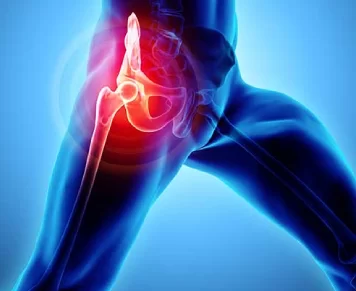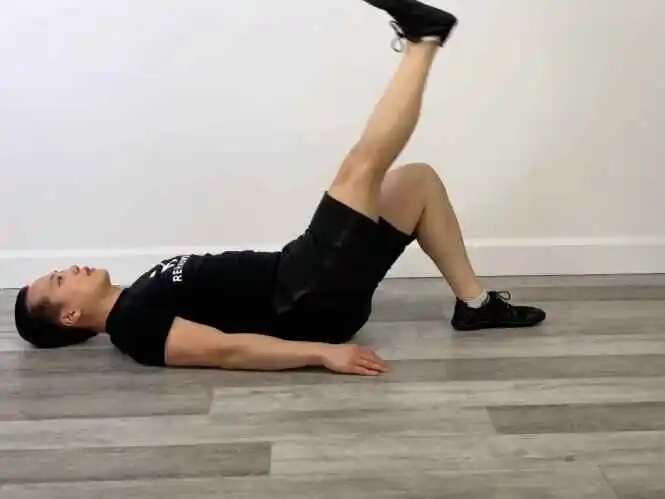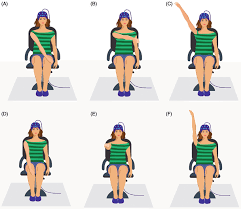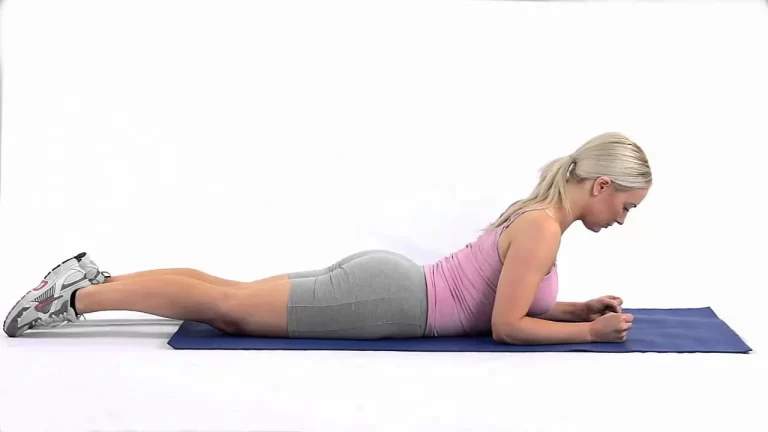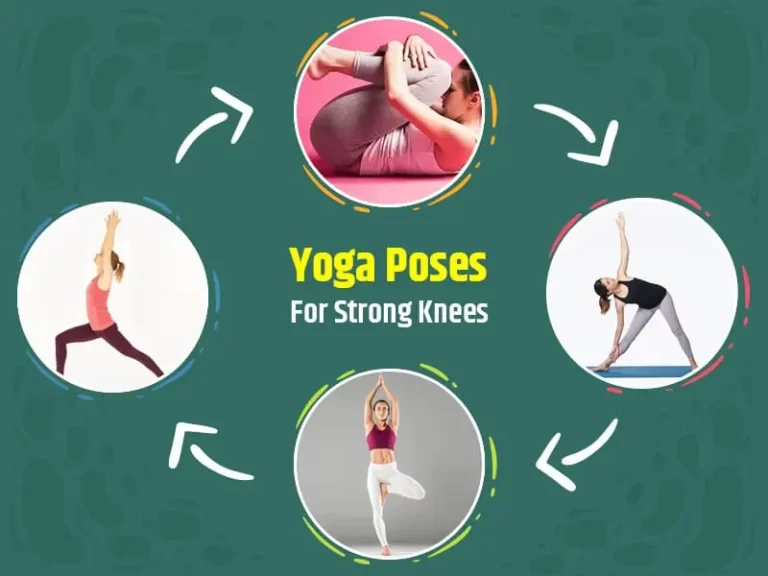28 Best Exercises for Wider Hips
Introduction
People who want wider hips need to work out specifically to develop their hip muscles. Although genetics has a significant role in hip width exercise can improve the tone and structure of the muscles. You cannot naturally change the bone structure you were born with.
However, by doing moderate exercise and modifying your diet, your hips and waist can be changed to highlight your entire appearance. Genetics plays a role in body shape, but certain activities can help you get the hip width you wish.
Toning and shaping your hips requires choosing the right exercises and eating a balanced diet. Strengthening and extending the muscles in this area will improve flexibility and stability in addition to preventing injury.
You surround your legs with small resistance bands, which are elastic loops when doing lower body exercises. The strong activation of your hip and glute muscles by the concentric resistance will make your figure more attractive and bootylicious.
Exercise plans are made to give you wider hips, firmer, rounder thighs, and more muscular legs that you can perform at home, in the gym, or on the go. To complete them, you only need a flexible workout band that may fit conveniently in your pocket and take up very little space.
The most common mistake that people make when wanting to widen their hips is focusing just on their gluteus medius. It is not the only direction, even though it is an important one in the development of broad hips. Even if they are unable to achieve an hourglass physique, people of all body types can utilize specific exercises to improve muscle and achieve an attractive pear shape.
Which muscles to work on to give your hips a wider appearance:
To develop the muscles of the outer hip, concentrate on hip abduction exercises (moving the leg away from the centerline) and external rotation activities (which turn the thigh bone far from the midline, so the knee and feet point slightly outward).
This is the largest muscle in the thighs, which gives your back a bigger shape. The gluteus maximus is responsible for the external rotation of the leg and hip extension (leg back).
- Glute medius
It’s advisable to focus on this area if you want your hips to appear wider. It has the highest muscle mass among the hip abductors, except the glute max, which only helps in abduction. It is specialized for lateral motion, serves as an important hip and knee stabilizer, and with practice, might show some increase in the hip-rounding muscles.
- Glute minimus
The glute medius is a small glute muscle that is located behind the other gluteal muscles in the hip. Its function is to support and abduct the hip.
Connected to the glutes, this muscle works in coordination with the other three muscles to allow a variety of hip movements. The TFL’s attachment to the iliotibial band (IT band) affects knee flexion as well.
The benefits of having wider hips:
It’s not proper to widen your hips just for appearance. You’ll experience improved posture, greater convenience whilst sitting, and improved stability as growing bigger hips requires strengthening your quadriceps and glutes. Important activities like running and walking are influenced by the amount of muscle in your hips and thighs.
Exercises for Wider Hips:
By strengthening and toning the hip muscles with the use of the following exercises, the muscles can appear wider.
Squats
- Start by standing as far away as is comfortable.
- The toes should be moving a little.
- Move your hips as if you were getting comfortable in a chair.
- Keep your back straight and bend your knees so that they cross your second toe.
- To support your spine, keep the muscles in your abdomen pulled.
- When your thighs are close to the ground, release your breath as you rise and lower your hips.
- Ensure that your weight is in your heels and that your knees are facing slightly outward.
- Use your thigh muscles to press into the ground as you stand up.
- By extending your knees with your quadriceps, you can get back into an upright position.
- Then return to your neutral position.
- Then relax.
- Repeat this exercise five to ten times.
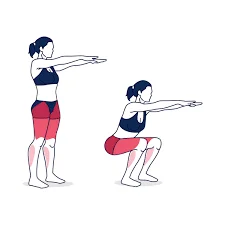
Side-lying leg raise
- Lay down on a mat or a small, soft surface.
- Now, while maintaining a neutral posture for your head, neck, and back, turn to the right.
- To achieve a comfortable position, raise your hand to your head and use your arm for support.
- Now raise one leg above the other.
- Slowly lift your left leg as high as possible and hold it there for a few seconds.
- Then lower your leg.
- Then return to your neutral position.
- Then relax.
- Repeat this exercise five to ten times.
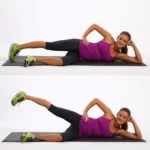
Single-Leg Glute Bridge
- Legs flat on the floor, knees bent, lie back on a mat.
- With your feet hip-distance apart, maintain your hands by your sides.
- Raise your hips so they are aligned with the ceiling.
- At the point where your hips and thighs are parallel, stop.
- Maintain the posture for a few seconds, or for however long it is comfortable for you.
- Lower your hips slowly.
- Then return to your neutral position.
- Then relax.
- Repeat this exercise five to ten times.
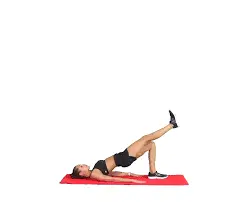
Stair climbing
- Take into comfortable, supportive, and well-fitting shoes with enough internal cushioning.
- Use non-slick outside soles to lessen the possibility of falling.
- Choose steps that are sturdy and have enough light.
- Maintain a straight neck and relaxed shoulders while climbing.
- Prevent from bending over.
- Try to make as little noise as possible as you rise; if you make a lot, it may be an indication that your knees and other joints are being overworked.
- It is best to keep your speed moderate and even, pausing only when necessary, rather than trying to climb too quickly.
- Avoid trying to climb by jumping up and down steps.
- To avoid harming yourself, you should gradually develop your stamina over a few weeks rather than trying to complete many steps at once.
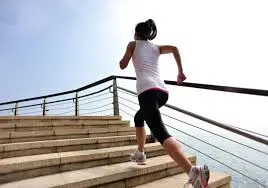
Duck walk
- Position your feet about shoulder-width apart.
- Bending at the knees allows you to squat down, bringing your hips down and behind you. (considering you are going to take a seat.)
- Maintain a straight back and lower as far as you can without raising your heels or toes.
- To improve your balance, raise your arms in front of you.
- Step forward with one foot, planting level on the ground while maintaining the same distance between your hips and the floor.
- Put your other foot forward and take a step forward.
- If necessary, repeat walking forward before reversing to go backward.
- Then return to your neutral position.
- Then relax.
- Repeat this exercise five to ten times.
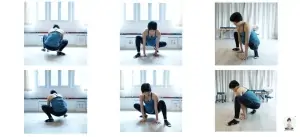
The Frankenstein walk
- Take place yourself on the ground in a comfortable position first.
- Raise your arms in front of you, keeping your hands facing down.
- Make a 90-degree angle with your body by extending your right leg straight up and out as you move.
- Swing your left leg up in the same manner as you lowered your right leg to the floor.
- If you reach out of place, keep going for a minute or so and choose a different path.
- Then return to your neutral position.
- Then relax.
- Repeat this exercise five to ten times.
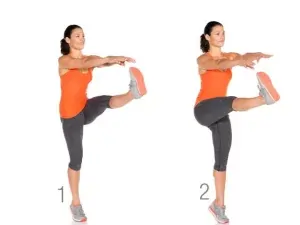
Chair pose arm forward
- Put your arms by your sides and your feet together in a straight line.
- Stretch your hands forward with your palms facing downward.
- Maintain a straight elbow position.
- As if you were sitting on a chair, put your pelvis down and bend your knees.
- Try visualizing yourself sitting inactive, either reading a newspaper or using a laptop, to better understand the Chair Pose.
- Make certain that your hands stay in line with the floor.
- With your spine extended mindfully, sit up straight.
- Make sure your knees don’t go past your toes as you gradually drop into the chair.
- After making your way down gradually, sit in this pose.
- Then return to your neutral position.
- Then relax.
- Repeat this exercise five to ten times.
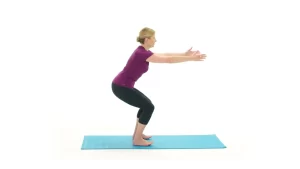
Side lunges
- Put your feet together and take an upright position first.
- Step out to the side, keeping your left leg and foot out to the side and ensuring that your bent knee is in line with your second toe.
- Take with your right foot and bend your knee as you land.
- Bend your right knee even further and shift your hips back to the neutral position while keeping your spine straight and your abdominals tight.
- Your entire body will move forward slightly.
- Keep your eyes forward and exhale after completing the previously mentioned movement.
- Push off with your right foot and get back up on your feet.
- Then return to your neutral position.
- Then relax.
- Repeat this exercise five to ten times.
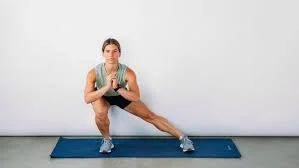
Step up with a dumbbell
- Place a weight in each hand and maintain a hip-width distance between your feet.
- Move onto a table or take a single step with your left knee forced up while maintaining your weight at your side.
- Hold this pose for a few seconds.
- Lower your left leg and get up from the table or take a step back.
- After that, continue with the other leg.
- Then return to your neutral position.
- Then relax.
- Repeat this exercise five to ten times.

Curtsy lunges
- Start by putting your feet together in a straight line.
- Bend both knees as you land and step your right leg behind your leg, maintaining an upright chest and tight abs.
- Keep your back knee pointing down toward the floor while bending, keeping both knees above your pair of shoes
- Your left leg shouldn’t move to the left.
- It might feel like the bones in your thighs are making an “X.”
- Hold this position for a few seconds.
- Then return to your neutral position.
- Then relax.
- Repeat this exercise five to ten times.
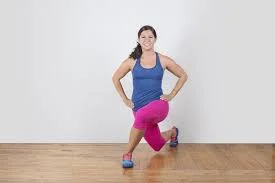
Leg circles
- Raise the opposite leg to keep balance when standing on one leg.
- Circle around the leg that is elevated.
- Draw 15–20 circles per direction.
- Now proceed to the opposite leg.
- Then return to your neutral position.
- Then relax.
- Repeat this exercise five to ten times.
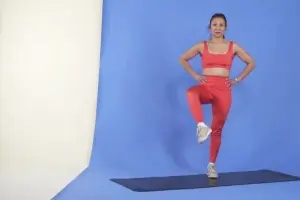
Squats with sidekicks
- Place both feet on the floor and take a standing position.
- Move your weight to your left foot and plant your right foot as you start to straighten your legs and stand properly.
- Bend your right knee to raise your foot off the ground.
- Raise your right leg straight up and to the side so that it is slightly in front of your shoulder while keeping your toe pointed forward.
- Lower yourself back into a squat by lowering your right leg to the floor and distributing your weight equally across both feet.
- Then return to your neutral position.
- Then relax.
- Repeat this exercise five to ten times.
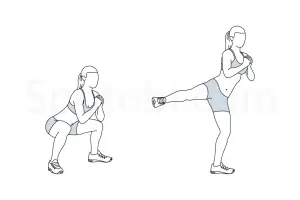
Hip Abduction in Squat
- Step down into a squat with your feet slightly wider than hip-width apart.
- You may strengthen yourself by doing resistance exercises.
- Next, let your right leg extend.
- Let your hips adjust to this movement.
- Step backward and extend your left leg in the same way after that.
- Be certain that you only move your left leg out, left leg back, right leg out, and right leg back during this activity.
- Hold your squat position at the same level for best results.
- Then return to your neutral position.
- Then relax.
- Repeat this exercise five to ten times.
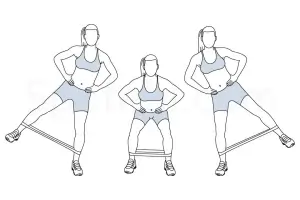
Pigeon poses
- To begin, find a comfortable seat and place your hands on the floor beside your knees.
- Now tighten the muscles in your abdomen.
- Then, bend your left knee forward and to the side.
- Move your right leg back and flex your right toes below.
- On the left side, toes apart.
- Maintain a straight back while looking up.
- Hold this position for a few seconds.
- Then return to your neutral position.
- Then relax.
- Repeat this exercise five to ten times.
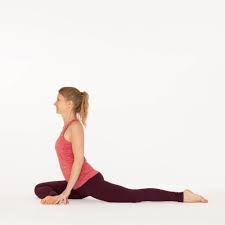
Side Plank Hip Dips
- Begin in the typical plank posture, on your hands and toes.
- Verify that your hands are firmly planted under your shoulders.
- Lift your left hand off the ground and make a full 180-degree turn to face left.
- Your right side ought to be facing the ground entirely.
- Contract your right obliques to keep your hip lifted and the right side of your body in a single, extended line.
- Release the breath and drop your right hip a few inches to the floor when you’re ready.
- Hold this pose for a few seconds.
- Inhale and tighten your right oblique muscles to bring your hips back up.
- Then relax.
- Repeat this exercise five to ten times.
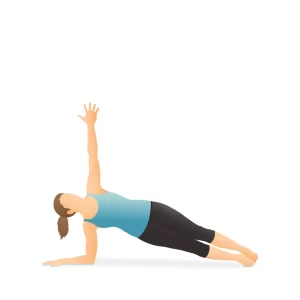
Romanian Deadlift
- Begin in a comfortable standing position on the ground.
- Using a dumbbell or barbell, place your weight in front of your thighs.
- Maintain a straight leg to the floor and your knees firmly above your heels.
- As you lower the weight, keep your shoulder blades pointed in the same direction and your head in line.
- Your hamstrings need to be tight.
- Once the weight is below your knees, move your hips to return to the starting position.
- Then relax.
- Repeat this exercise five to ten times.
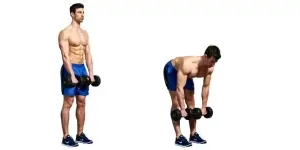
Bulgarian split squats
- Start this exercise by placing your feet shoulder-width apart and squatting slightly in front of a bench.
- Your body should be pointing forward and away from the bench at this point.
- Lift a weight onto your chest using a pronated grip (palms facing the floor) while holding a dumbbell in front of you.
- Lift the weight strongly above and set it down on your shoulders.
- This is the time to step one foot backward so that it rests on the level bench and place the other foot in front of you.
- Your head should always point forward during this preliminary phase, and your back should always be solid and straight.
- As you breathe in, progressively bend your leg down until you get a contraction.
- Make sure, though, that your knee is above your toes and is not touching the floor.
- Even so, face forward at all times with your chest out and your back straight.
- Lift your leg back to its starting position while exhaling and contracting your quadriceps.
- Then return to your neutral position.
- Then relax.
- Repeat this exercise five to ten times.
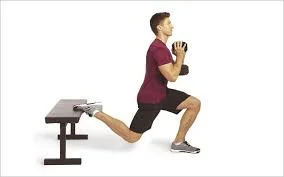
Lunge Kickback
- Step forward with your left leg, extend both knees to a 90-degree angle, and make sure your left knee is parallel to your left ankle to perform a lunge.
- Raise your right leg behind you while keeping your posture straight and transfer your weight to your left leg.
- Put your right leg back where it was before.
- Next, continue doing this movement for a short while.
- Return to a standing position once the workout is complete.
- Then relax.
- Repeat this exercise five to ten times.
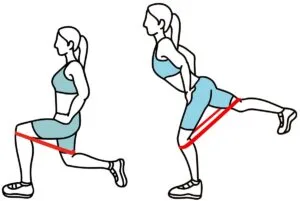
Hip marching
- With your feet flat on the floor and your knees bent, take a seat in a firm chair.
- As high as you can raise one leg while keeping your knee bent.
- Hold this position for a few seconds.
- Lower your leg slowly and gently.
- Once the exercise is complete, go back to the beginning position.
- Then relax.
- Repeat this exercise five to ten times.
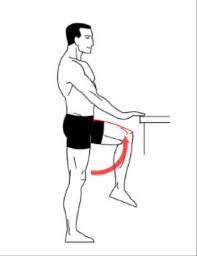
Fire Hydrants
- Place your wrists directly below your shoulders and your hips over your knees to begin in a quadrupedal position. (Using a yoga mat or another soft surface for your practice could be helpful.)
- Raise one leg off the ground and bend it outward as well as forward.
- Throughout the entire workout, your knee must remain bent.
- Squeeze your glutes together and hold this position for just a few seconds.
- You can maintain a straight spine and pelvis by contracting your abdominal muscles.
- Then return to your neutral position.
- Then relax.
- Repeat this exercise five to ten times.
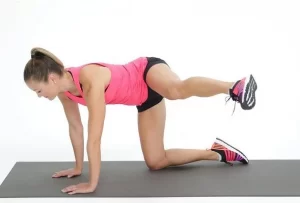
Hip lifts
- Begin by resting down with your legs spread wide at the hips, your feet flat on the floor, and your knees bent.
- Put your arms by your sides and keep yourself comfortable.
- Your hips will rise when your glutes contract.
- Keep your full weight on your shoulder blades rather than lifting it to your neck.
- Hold your inner thighs in contact with your outer thighs and keep your knees parallel to the floor while doing this.
- Before stepping back down to the beginning posture, pause and breathe once you reach the top of the posture.
- Then return to your neutral position.
- Then relax.
- Repeat this exercise five to ten times.

Sumo walks
- As you wrap the band around both legs, make sure it is flat and not curled, and place it just above each ankle.
- Toes should be shoulder-width apart.
- The band should be fit but not overly tight.
- After bending your knees slightly, go into a half-squat to activate your muscles.
- Place your feet parallel to your shoulders, keep your face forward, and evenly split your body weight between the two equitably over both feet.
- To maintain the half-squat, take a step back with the other leg while maintaining your weight on the other leg.
- Keep your hips level the entire time you perform the exercise.
- During this exercise, it is advantageous to maintain a low, forward-facing posture.
- You should have a straight back as opposed to a rounded one.
- Shift your legs and gradually change your weight.
- Then return to your neutral position.
- Then relax.
- Repeat this exercise five to ten times.
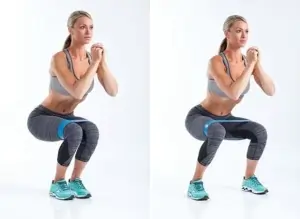
Banded-Glute-Bridge
- Select a resistance band based on your current level of fitness.
- With your back flat on the floor and your knees at a straight angle, maintain a floor position.
- Make sure the resistance band is just above your knees by wrapping it over both of your thighs.
- Stretch your knees out against the bands, lift your hips into space, and maintain your arms by your sides.
- Contract and then release your muscles for a duration of two to three seconds.
- Then return to your neutral position.
- Then relax.
- Repeat this exercise five to ten times.
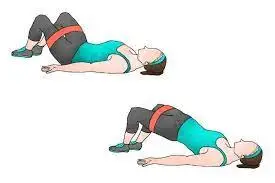
Donkey kick
- Lay down on the ground and put your hands over your head.
- Now put your hands under your shoulders and your knees below your hips.
- You can strengthen your back and pelvis by contracting your abdominal muscles.
- Pull your chin slightly lower and look down and out to keep a flat back of the neck.
- To engage your glutes, flex your right foot and keep your right leg at a 90-degree bend.
- Then, raise your right leg up and behind you toward the ceiling.
- Make sure your body height is just above the point where your hips twist or bend and your lower back arched structures, which indicates that you may have lifted it too high.
- You should maintain a firm, neutral back and keep your hips centered on the floor.
- Try not to rush your movements to finish the exercise with a full range of motion and proper technique.
- Start with lowering your right leg and then raising it back up.
- Then return to your neutral position.
- Then relax.
- Repeat this exercise five to ten times.
- Proceed to the left side after completing all of the repetitions on the right side.
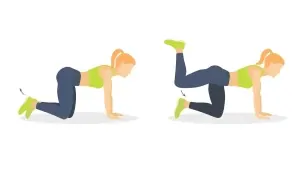
Clamshells
- Put your right side upward and lie down on a mat.
- Your hips should be flexed to a roughly 45-degree position, your knees bent at a 90-degree angle, and your feet stacked on top of each other.
- Place your head on your arm, a yoga block, or a towel.
- Extend one leg toward the ceiling while maintaining the other thigh on the floor, making sure that your hips remain straight to prevent them from expanding wide.
- Then return to your neutral position.
- Then relax.
- Repeat this exercise five to ten times.
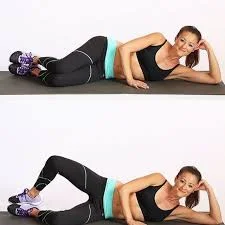
Plank Kickback with Resistance band
- Holding the other end of the resistance band with your hands, wrap it around your right foot.
- In step two, get down on your hands and knees.
- Kick back while holding the band tightly with your right foot inside of it.
- There should be a straight move from extended to locked out leg.
- Then return to your neutral position.
- Then relax.
- Repeat this exercise five to ten times.
Hip Thrust
- Take a position where your back is against an elevated surface (like a bench or box) and your feet are flat on the floor with your knees bent.
- With the support exactly under your shoulder blades, place your feet shoulder-width apart.
- Your legs should be at a 90-degree angle as you push through your heels to bring your thighs parallel to the floor while keeping your chin pulled in.
- Tighten your glutes at the highest point and return to the starting position.
- Then return to your neutral position.
- Then relax.
- Repeat this exercise five to ten times.
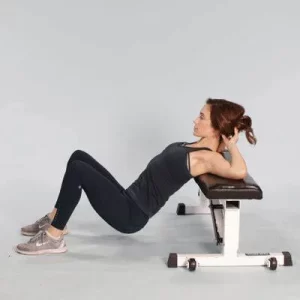
Crab walk
- Place your arms behind your back, facing your hips with your fingers pointing in that direction, and start from the floor with your feet hip-distance apart in front of you.
- Maintaining your feet wide apart, your abdominal muscles squeezed and your palms on the floor behind your butt can help protect your back.
- Push your hips above the floor while contracting your core.
- To start “walking” ahead, move your left hand first, then your right foot, and lastly your right hand, then your left foot.
- Take four or more steps when space allows, then turn around.
- Continue back and forth for as long as you need to.
- Then return to your neutral position.
- Then relax.
- Repeat this exercise five to ten times.
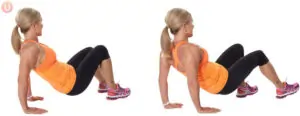
Use these recommendations to exercise safely:
You may lower your risk of injury and maintain a safe and efficient exercise program for the muscles surrounding your hips by taking these preventative measures.
- Avoid engaging in an activity if it hurts you.
- Increase the number of repetitions and duration of your exercises gradually to prevent overtraining and aching muscles.
- It would be great to use the proper instruments.
- Remember to use the correct technique when doing out because the improper form can lead to injury and not produce the desired results.
- Put on loose-fitting clothes and comfy shoes.
- Make sure your body is well warmed up before exercising.
- If you experience any sharp discomfort or sharp pain throughout the workout, stop right and immediately see a doctor.
- It’s important to give yourself enough time off between workouts so that your muscles can recover.
- Water must be consumed to stay hydrated and preserve optimal muscle function. Make sure you stay hydrated before, during, and after your exercise.
When was the individual’s participation in exercise therapy stopped?
- Muscle pain shouldn’t be tolerated in working.
- If there’s any discomfort or numbness.
- Fever
- Headache
- If exercising hurts, you should stop.
Summary
The bone structure you were born with cannot be naturally changed. With moderate exercise and a well-balanced diet, you can still realign your hips and abdomen to give yourself an hourglass shape. These workouts are the initial step toward the hips. follow these workouts regularly and ignore all other advice for optimal results. For a more healthy and powerful lower body, having strong hips is important, even though you cannot specifically tone or concentrate on the pelvic region.
Building stronger hips is important for a more muscular and healthy lower body, even though the pelvic area cannot be specifically targeted or toned. Combine intense exercise with good form to build muscle and enlarge your hips.
Exercise has many advantages, even when it is focused on the hip region. With the right form, performing heavy lifting exercises can widen your hips and add muscle. Having wider, more attractive hips is practically a blessing in concealment, but this can only be achieved by exercising and training in a specific way to reduce body fat and develop firmer, rounder hips.
FAQ:
Do hips grow wider naturally?
There are no natural ways to significantly enlarge your hips because the size of your hips is largely determined by your bone structure, exercises like squats, lunges, and hip abductor exercises can help you focus on building muscle in the glute and hip regions.
How Can I Get Wider Hips?
Engaging in specific activities will help tone and strengthen the muscles in your hip and waist region. They include squats, side lunges, and fire hydrants.
How healthy are your hips?
Hip health is essential for most movements, such as bending, walking, running, and sitting. Hip pain can significantly limit your daily activities. Hip pain can result from a wide range of illnesses, including rheumatic disorders that affect the joints and connective tissues, such as arthritis.
What muscle causes your hips to grow wider?
The group of muscles in the buttock area known as the gluteal muscles consists of the gluteus maximus, gluteus medius, and gluteus minimus. The largest and most superficial of the three muscles, the gluteus maximus, forms most of the shape and form of the buttock and hip region.
Can I work out my hips every day?
Yes, you can perform hip exercises daily, but you should adjust the focus and intensity of your workouts to prevent overuse problems. Don’t forget to include rest days, and be aware of any signs of exhaustion or tension in your body.
Are hips that are wider a good thing?
Having small hips is not better or healthful. It might be better for hips to be wider, especially for women. Working out that targets both your total body fat and your lower body can help you get leaner hips.
Which exercise is best for building hip growth?
Squats
Bulgarian split squats
Hip lifts
Frankenstein walk
Romanian Deadlift
How can I gain wider hips the quickest?
Many workouts are effective, but the ones that affect the hips the fastest and most significantly are squats and lunges.
Wide hips are they normal?
The first step in finding what you want is accepting the body you have and realizing that having wide hips is natural and healthful.
References:
- October 13, 2021: Colletta, M. Ten Great Exercises that Can Help Your Hips Get WiderAdditives made of steel. Ten fantastic exercises to achieve wider hips: https://steelsupplements.com/blogs/steel-blog Colletta, 2021 is cited in the text.
- P. Bansal (unknown). Justmyhealth.com/workouts-for-more-toned-hips-1629289826. Five Hip-Wider And More Toned Exercises Internal citation: Bansal, not available.
- Sport Atemi. 10 At-Home Workouts for Broader Hips (2023, April 19). T. An in-text citation for Atemi Sports’ “10 Exercises for Wider Hips You Can Do at Home” is as follows: workouts for wider hips at atemi-sports.com.
- Surgeon R. R. E. H. A. N. (2021, November 5). Which Athletes Are Best for Your Hips? fifteen exercises for the hips. HealthNet. Which Exercise Is Ideal for Your Hips? /article.htm on www.medicinenet.com Within text citation: Surgeon (2021)
- May 30, 2023, Cpt, T. C. Is It Possible to Get Wider Hips Through Exercise? Hip-flexor exercises: How to Get Wider Hips: https://www.healthline.com/health/fitness-exercise Internal citation: (Cpt, 2023)
- January 26, 2021: Speck, C. These 10 Exercises Will Help Your Hips Expand. Fitplan Blog. Citation within the text: (Speck, 2021). https://blog.fitplanapp.com/how-to-get-wider-hips-10-effective-exercises
- Image 4, (2020, February 21) Stohler, C., & Images, L. A Flat Stomach: Climbing Stairs. Livestrong.net. The article “Climbing stairs for a flat stomach” can be found at https://www.livestrong.com.
Internal Reference: (Stohler & Images, 2020) - Image 5, Duck Walk: Ideal Positioning for Mothers. (n.d.). The ideal positioning of the mother. Duck Walk: https://www.optimalmaternalpositioning.com/ In-text Citation: (Optimal Maternal Positioning by Duck Walk, n.d.)
- Image 6, S. Abraham (2022, Aug. 2). The Best 5 Pre-Marathon Warm-Up Activities. Unbroken Leaves. The top five warm-up exercises for runners before the Himalayan Marathon are available here.
In-text Reference: Abraham (2022) - Image 7, Polsgrove, M., Lockyer, R., and Eggleston, B. (2016). Effect of ten weeks of yoga on collegiate athletes’ balance and flexibility. Yoga International Journal, 9(1), 27. The DOI is 10.4103/0973-6131.171710.
Citation inside the text: Polsgrove et al. (2016) - Image 8, K. Buick Buick, 2021, August 3. This killer kind of lateral lunge will target both your inner and outer thighs. Women’s Welfare. The way to perform a lateral lunge is explained at https://www.womenshealthmag.com/uk/fitness/workouts/a700321/
Reference inside text: (Buick, 2021). - Image 9, L. Putra (2023, Jan. 3). Get the Man Stepping Up with a Dumbbell workout. Vector illustration in flat style, isolated on a white backdrop 6417… The vector artwork of a man performing dumbbell step-ups and exercises on a white backdrop can be found on Vecteezy.
Reference within the text: Putra, 2023 - Image 10, Putra, L., January 3, 2023. This is an activity called “Woman Performing Side Lunge to Curtsy Lunge.” A solitary, straightforward vector design against a white background “Woman training side lunges to curtsy lunge actions phase as a vector picture on a white frame” is a vector artwork available on Vecteezy.
Citation inside the text: Putra, 2023 - Image 11, Online Store 96012887 (n.d.). 96012887.html is the product detail page at Rugoodet. live.
Reference within the text: (96012887 – Online Store, n.d.) - Image 12, D. (2021, June 8). Exercise Guide with Illustrations: Squat Side Kick. SPOTEBI. The following exercise: squat side kick.
Citation inside the text: (2021) - Image 13, D. (15 July 2021). An Illustrated Exercise Guide for Squat Band Hip Abduction. The Squat Band Hip Abduction is a workout guide available on SPOTEBI.
Citation inside text: (2021) - Image 15, The online store 95677828 (n.d.). The product details for Senicessm are 95677828. html.
Reference within the text: (95677828 – Online Store, n.d.) - Image 16, Neudecker, K., and Hayes, A. (2023, June 2). How to Perform the Romanian Deadlift to Build Larger, More Powerful Legs. Male Health. Roman Deadlift Beginners Guide: https://www.menshealth.com/uk/building-muscle/a29202950
Reference within the text: Hayes & Neudecker, 2023 - Image 18, Atemi Sports. 2023, February 13; ” ten The resistance Band Glute Exercises for Developing the Ideal Bottom” Resistance band glute exercises from Atemi Sports. https://atemi-sports.com/
Reference inside text: (10 Resistance Band Glute Exercises to Create the Ideal Booty – Atemi Sports, 2023) - Image 19, Exercise, Global Health Spine and Laser Center, n.d. Exercise: seated hip march (https://ghspineandlasercentre.com)
Reference inside text: (Exercise, Global Health Spine and Laser Center, n.d.) - Image 21, K. (July 19, 2015). Elevate your hips. Wizard of Bodybuilding. hip-raise: https://bodybuilding-wizard.com/
Internal Reference: (2015) - Image 22, May 29, 2020: Paiz, C. Six Glutes Moves To Firm Your Lower Abs. [https://in.pinterest.com/pin/451556300136182648/]. Pinterest
Reference inside text: Pavez, 2020 - Image 26, Eight Booty-Building Powerband Mini Exercises on the Go: Let’s BandsTM – Blog (n.d.). Booty-building-powerband-mini-exercises: https://letsbands.com/en/blog/
Reference within text: Let’s Bands TM – Blog – 8 Booty-Building Powerband Mini Exercises on the ground. - Image 27, A. June 9, 2021. Booty Builder. “How to Do Hip Thrusts.” https://bootybuilder.com/how-to-do-hip-thrusts/
In-text Reference: (2021) - Image 28, Cpt, C. F. (15 March 2024). How To Do The Crab Walk (With Proper Form & Exercises). Chris Freytag | Get Healthy U. /exercise/crab-walk/ on gethealthyu.com
Reference inside text: (Cpt, 2024)


